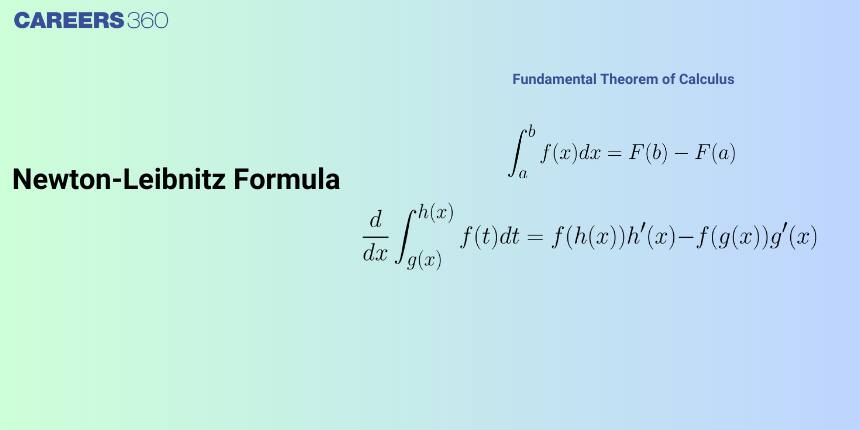Newton-Leibnitz's Formula
Newton Leibnitz's Theorem is one of the important parts of Calculus, which applies to measuring the change in the function at a certain point. Mathematically, it forms a powerful tool by which slopes of functions are determined, the maximum and minimum of functions found, and problems on motion, growth, and decay, to name a few. These integration concepts have been broadly applied in branches of mathematics, physics, engineering, economics, and biology.
JEE Main 2025: Sample Papers | Mock Tests | PYQs | Study Plan 100 Days
JEE Main 2025: Maths Formulas | Study Materials
JEE Main 2025: Syllabus | Preparation Guide | High Scoring Topics
- Newton Leibnitz's Theorem
- Solved Examples Based on Newton Leibnitz's Theorem
- Summary

Newton Leibnitz's Theorem
Newton Leibnitz's Theorem states that If the functions u(x) and v(x) are defined and f(t) is a continuous function, then
It gives us the condition to differentiate the definite integral of which limits are functions of a different variable. When the limits of the integral are completely different functions compared to the function of the integral sign, then the Newton-Leibniz method is applicable. This is used to find the derivative of the integration. It is only useful in the case of definite integral. It can be used to find the differentiation of the nth order.
Definite integration calculates the area under a curve between two specific points on the x-axis.
Let f be a function of x defined on the closed interval [a, b]. F be another function such that
Proof:
Recommended Video Based on Newton Leibnitz's Theorem
Solved Examples Based on Newton Leibnitz's Theorem
Example 1: Let
1) 18
2) 24
3) 36
4) 12
Solution
As we learnt in
NEWTON LEIBNITZ THEOREM -
Hence, the answer is the option 1.
Example 2: If
then
1)
2)
3)
4)
Solution
As we have learned
NEWTON LEIBNITZ THEOREM -
Thus
Hence, the answer is the option 3.
Example 3: Let
1) 5/4
2) 7
3) 4
4) 2
Solution
As we learned
NEWTON LEIBNITZ THEOREM -
Hence, the answer is the option (3).
Example 4:
1) 1
2) 2
3) 0
4) 0.5
Solution
As we learned
NEWTON LEIBNITZ THEOREM -
Limit=
Hence, the answer is the option (1).
Example 5: if
1) 3
2)
3)
4)
Solution
As we learned
NEWTON LEIBNITZ THEOREM -
On differentiating both sides, we get
Hence, the answer is the option (1).
Summary
Newton Lebinzn's theorem is a powerful tool in calculus that allows us to calculate the area under a curve between two specific points. It provides a deeper understanding of mathematical ideas paramount for later developments in many scientific and engineering disciplines.
Also Read
14 Feb'25 10:25 PM
14 Feb'25 10:23 PM
14 Feb'25 10:21 PM
14 Feb'25 10:18 PM
14 Feb'25 10:15 PM
14 Feb'25 10:00 PM
14 Feb'25 09:58 PM
14 Feb'25 09:53 PM
14 Feb'25 09:50 PM
